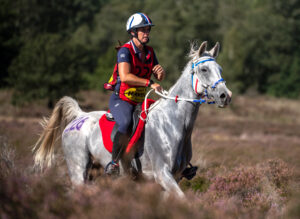A suspensory injury can potentially be very serious, and early diagnosis and treatment are essential to give the horse the best chance to recover fully.
Today, we’ll discuss everything horse owners need to know about suspensory ligament injury in horses, its causes, and potential treatments. But first, let’s familiarize ourselves with the structures involved to understand why and how this injury occurs.
Suspensory Ligament Horse Anatomy

Courtesy: AG Update
The suspensory ligament is a fibrous structure that runs down the back of the cannon bone from below the knee or hock, beneath the two flexor tendons and between the splint bones. It can easily be felt and seen in the mid-cannon area.
Suspensory ligaments work along with other structures to support the horse’s leg. Its primary function is to prevent excessive extension of the fetlock joint and absorb shock.
Jumpers and racing horses are most at risk of acute front suspensory tears because jumping and running at speed increases the load on their forelimb and the chances of a misstep.
On the other hand, as a dressage horse progresses in its training, it is asked to carry more weight on its hindquarters. This shift in weight and increased engagement of the hind legs is to achieve advanced movements such as piaffe, passage, pirouettes, and more.
Due to this increased demand on the hindquarters, there is greater stress placed on the hind limb’s structures, including the suspensory ligaments.
Nevertheless, all horses are at risk of injury, and the risk increases with work intensity, lack of fitness, and poor footing.
What is a Horse Suspensory Ligament Injury?
As mentioned, a horse suspensory ligament injury is an injury to the tendon-like band that runs from the back of the cannon bone or the suspensory ligament.
This injury may occur because of a single traumatic event, a long-term age-related degeneration, or a repetitive strain on the ligament. An over-stretching injury can also lead to damage, including slight tearing of fibers at the upper cannon bone (level of their origin) or the sesamoid bone (their insertion).
Three regions of the suspensory ligament that may be injured:
- Proximal suspensory desmitis (top end) – occurs when fibers that comprise the ligament tear near its origin or a hairline crack appears in the bone. Damage at this part of the suspensory ligament invariably causes mild to severe lameness.
- Mid-body – happens when the ligament tears somewhere between where it branches or leaves the cannon bone.
- The two suspensory ligament branches – Branch tears occur in one branch or both. Lameness associated with a branch injury may improve within days.
A suspensory ligament injury must be treated immediately, as should any damage to the horse’s tendon. Failure to do so can limit the horse’s movement or, worse, end its career in sports.
Sometimes, even if the body and branch injuries heal, the repaired tissue is not as strong as before. However, a full recovery is possible if you identify the symptoms early and treat them immediately.
Just be aware that the suspensory ligament may heal very slowly, like tendons, because of the weak scar tissue that has replaced the damaged, strong, stretchy tissue.
Courtesy: Getty Images
Causes and symptoms of a suspensory injury
When a horse runs or jumps, it can place a lot of stress on the suspensory ligament and cause it to overstretch. The severity of the tear depends on how much damage was done to the fibers. Other causes include poor trimming or shoeing, training or working a horse on hard, uneven, or overly soft surfaces, direct trauma or a rapid increase in the intensity of their exercise.
Here are the common symptoms of suspensory ligament injury in horses:
- Lameness – Can range from mild to severe
- Swelling – The affected limb may be warm to the touch and exhibit localized swelling
- Local tenderness – The horse might react when the area over the suspensory ligament is pressed.
- Change in performance – Even if lameness is not evident. The horse might be reluctant to turn, jump, or move forward at its usual pace.
Diagnosis
Horse suspensory ligament injuries are often misdiagnosed because there can be little to no swelling in the limbs. Even lameness may be relatively minimal and come and go, resolving itself after rest.
Often, the most effective way to diagnose an injury is by doing an ultrasound. It will show any inflammation, tears or damage to the ligament. Veterinarians often perform a lameness evaluation, which may include having the horse trot in a straight line, on a lunge line, or under saddle. Flexion tests might also be used. While these can suggest the location of the pain, they don’t specifically pinpoint a suspensory injury.
Prevention of suspensory ligament injuries using carnosine
Carnosine is a naturally occurring substance in both the human and animal body and has been found to prevent injury to tendons and joints effectively.
Both carnosine and L-carnosine have been extensively studied for their potential health benefits. That includes their ability to improve athletic performance and prevent age-related decline in cognitive function.
As discussed, the suspensory ligament lies between the splint bones and may be felt in the mid-cannon area. By using a carnosine horse gel on this area before training sessions or rides, you’re giving your horse an added layer of protection for that vital ligament.
How does carnosine work to prevent injury & increase performance?
Studies of carnosine show it contributes to healthy joints, ligaments and tendons, as well as improved exercise performance. Beneficial characteristics of carnosine include PH buffering, anti-glycation and antioxidant properties. [2]

Let’s take a closer look at each characteristic and how it can help keep ligaments healthy.
- PH Buffering
During intense exercise, lactic acid builds up in the muscle. Carnosine acts as a buffer to reduce the buildup of lactic acid and, therefore, delay the onset of muscle fatigue and improve muscle endurance. This allows horses to train for longer periods of time without injury. [3]
- Anti-Glycation
Think of glycation as the “stiffening” of tissues. When sugar molecules stick to proteins, they can make tissues less flexible, like rubber bands lose their stretch over time. By countering this, carnosine helps keep tendons and ligaments more elastic and functional.
- Antioxidant
Carnosine’s role as an antioxidant means it can combat oxidative stress in the body. Oxidative stress can harm cells and is believed to play a role in aging and various health issues.
In everyday terms, carnosine is like a shield that protects a horse’s body from harmful molecules called free radicals. These free radicals can damage cells, including those in tendons, ligaments, and joints.
What is the most effective way to get the benefits of carnosine?
Although you can increase carnosine levels by means of diet and supplementation, the most effective way is to directly apply it to a horse’s muscles, tendons and joints. Apply a small palmful of a tried and tested equine gel like Carnogel for strong and healthy suspensory ligaments.

Courtesy: Getty Images
Conclusion
Healing of a suspensory ligament can be a long and tricky process. Mild strains might require up to two months to mend, while more severe tears can take a year.
Remember that although a horse might seem ready to get back on track, trotting without any signs of pain, healing might still be ongoing on the inside. Jumping the gun on their rehabilitation could lead to more issues down the line. Furthermore, ligaments often heal with a type of scar tissue that’s more susceptible to future injuries.
However, by proactively using a carnosine equine gel, you can prevent injuries to all ligaments, joints and tendons, keeping your horse in the best condition possible.





